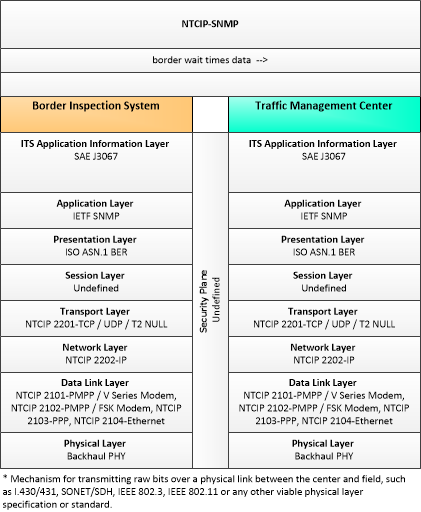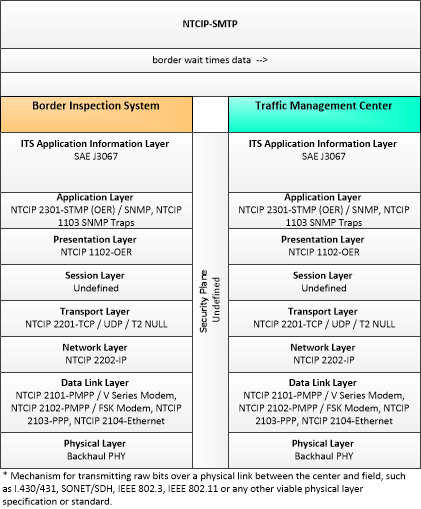Link Type: Center to Field
Border Inspection System --> Traffic Management Center:
border wait times data
Definitions
border wait times data (Information Flow): Measure of current, actual, or predicted wait time at border. Measurement provided by vehicle type, lane, and type of lane (e.g. NEXUS vs. regular).
Border Inspection System (Source Physical Object): 'Border Inspection System' represents data systems used at the border for the inspection of people or goods. It supports immigration, customs (trade), agricultural, and FDA inspections as applicable. It includes sensors and surveillance systems to identify and classify drivers and their cargo as they approach a border crossing, the systems used to interface with the back-office administration systems and provide information on status of the crossing or events.
Traffic Management Center (Destination Physical Object): The 'Traffic Management Center' monitors and controls traffic and the road network. It represents centers that manage a broad range of transportation facilities including freeway systems, rural and suburban highway systems, and urban and suburban traffic control systems. It communicates with ITS Roadway Equipment and Connected Vehicle Roadside Equipment (RSE) to monitor and manage traffic flow and monitor the condition of the roadway, surrounding environmental conditions, and field equipment status. It manages traffic and transportation resources to support allied agencies in responding to, and recovering from, incidents ranging from minor traffic incidents through major disasters.
Included In
This Information Flow is in the following Applications:
This Information Flow is in the following Application Objects:
Communication Diagrams
The communication diagram(s) can be viewed in SVG or PNG format and the current format is SVG. Switch to PNG format.
This profile describes an alternative set of standards used to communicate with ITS Roadway Devices that uses the NTCIP Octet Encoding Rules (OER), a standard developed specifically for the transportation industry. This template is used primarily for communication with traffic signal controllers, where second-per-second communications is required. This template also includes standards for SNMP traps, that allows an ITS Roadway Device to initiate event-driven communications with a receiver.
Characteristics
Architectural:
| Characteristic | Value |
|---|---|
| Time Context | Recent |
| Spatial Context | Local |
| Acknowledgement | True |
| Cardinality | Unicast |
| Initiator | Source |
Security
This information flow triple is in the following applications with the following security levels.
| Information Flow Security | |||||
|---|---|---|---|---|---|
| Application | Confidentiality | Integrity | Availability | ||
| Basis | Basis | Basis | |||
| Border Management Systems | Not Applicable | Low | Low | ||
| This is directly observable data. | If this information is used to determine how thoroughly to investigate passing vehicles (ie. When it is busy vehicles are subject to less thorough inspection) this flow could be bumped up to a MEDIUM. | If this information is not fully up to date, or is missing, the system can still operate properly. | |||

